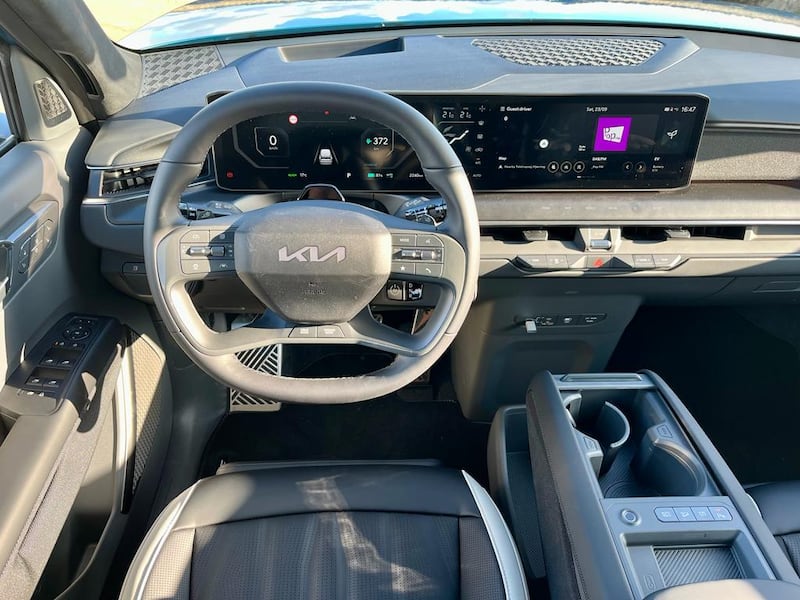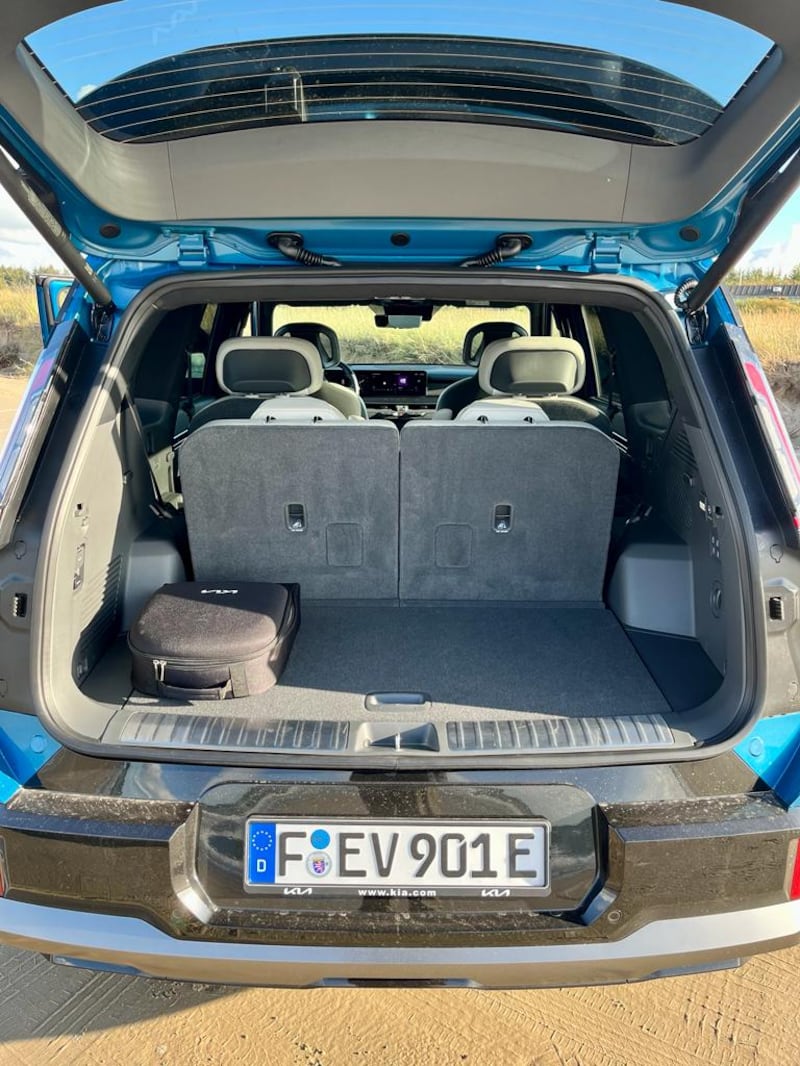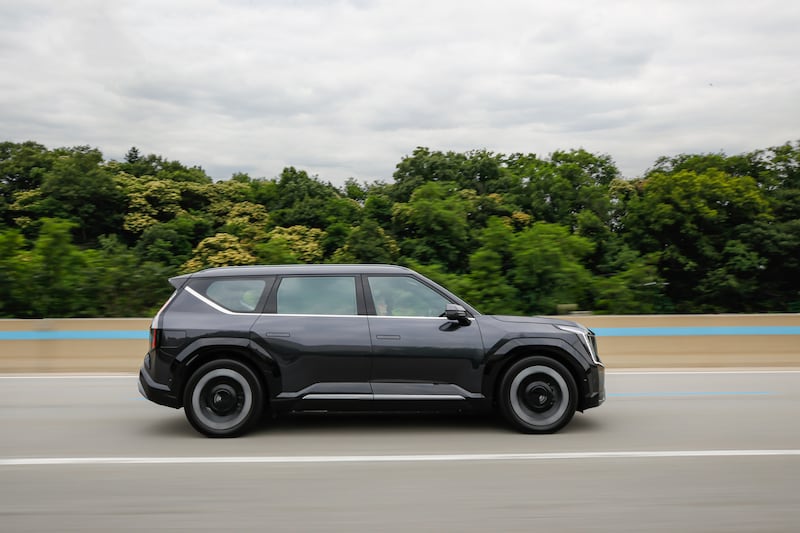The photos suggest Kia’s new all-electric EV9 has stature of an army personnel carrier, often drawing comparisons online to the Range Rover – much to the chagrin of the landed gentry.
Yet, in the metal, the EV9 is more subtle than it appears. Certainly, it has chiselled lines. And there are touches that were drawn with the same T-square used at Land Rover. But its stance is lower than you might expect, particularly in a car park where the BMW X5 looks diminutive these days.
Externally the EV9 is quite striking. Highlights include the stylised light clusters up front and that large solid front nose that resembles a front gate in most pictures but is more subdued in the metal.
Inside, it’s certainly spacious. This is a proper seven-seater and the third row will accommodate mid-sized teens and adults for a long trip, helped by electrically adjustable backrests.
What time is kick-off and what TV channel is Wales v Ireland on? All you need to know about the Six Nations clash
What next for James Bond under Amazon? Marvel-style TV spinoffs on Prime or Miss Moneypenny specials?
Amaya Fusion takeaway review: Indian favourites with distinctive character in Rathfarnham
Unpaid or poorly paid entry-level creative jobs are subsidised by wealthy parents
[ Kia targets premium buyers with new all-electric seven-seaterOpens in new window ]
The boot is big even with the rear seats up, boasting saloon car space of 571 litres and a large 2,320 litres with back rows lowered; a task that is also completed at the touch of a button on the boot wall.
It’s upfront that things get a little less impressive. The touchscreen and controls are as slick as you get on other EVs these days. Kia has been praised for mix of haptic touch sensor buttons and controls, plus a nice clear touchscreen.


But we were hoping for more. For example, the quality of the plastic switchgear and the tactile feel of the finish is sturdy, but not of the premium finish we’d expect of a car that carries a €77,000 or more price tag. Given the work done on the exterior, we’d have hoped the cabin would have received as much attention as well.
Behind the wheel, the Kia is swift and easy to navigate, even in tight urban car parks. Yet it’s never engaging to drive.
It will cruise along at motorway speeds and holds itself upright in the bends with little bodyroll. That’s down to the hefty battery pack that’s crammed under the floor.
Kia will offer two variants to Irish customers. The entry model is the rear-wheel drive “Earth” version, with a 99.8kWh battery pack, seven-seats but in rear-wheel drive format that promises 563km on a full charge. Prices start at €77,500.
The next grade is “GT Line”, with the same battery pack but all-wheel drive format that brings the official range to 512km. This version is also offered in either six- or seven-seat format.
Our test car was the six-seater GT Line and while the official WLTP range is reckoned to be 512km, that clearly varies with driving style. During our time behind the wheel, we achieved figures of 19.6kWh/100km in urban driving, but our average on regular country roads was 30.4kWh/100km, which equates to closer to 350 kms on a full charge.
The GT-Line also manages to deliver a 0-100km/h time of 5.3 seconds, which is significantly quicker than the Earth version (9.4 seconds) but also faster than a regular EV6. There is talk of a fully-fledged GT version in the future, but do you really want to be faster than 5 seconds in a 3-tonne SUV loaded with your kith and kin?
And yes, we are talking about a car that weighs in at 2,648kgs to be precise. That’s on a par with the likes of the Ford Raptor pickup truck.
Perhaps that’s why Kia has opted to keep the driving dynamics so neutral. There’s a decent weighting to the steering feel, something we were concerned about, given that this car is primarily targeted for buyers on the other side of the Atlantic.

Thanks to that weighting, the response from the steering is quick, but it just feels like you are pointing and clicking with this car rather than driving it.
This is a problem for many mainstream EVs, but if Kia wants to play alongside the premium brands then it needs to deliver a more entertaining drive. Think of the driving pleasure Audi, BMW and Mercedes-Benz can deliver from their EVs.
Kia’s engineers have made enormous leaps in recent years, epitomised by the engaging all-electric EV6. Here, they’ve delivered finesse and comfort, but it lacks that extra spark we’d hoped for in its driving dynamics.
But perhaps the story of EV9 was never meant to be about driving; it’s all about size and space. Kia certainly makes a statement here, delivering a proper three-row seven-seat all-electric family car and one that stands out from the mainstream crowd.
As the brand’s flagship model, it carries a big price tag, but not one that would scare off the top-end SUV buyers who are looking for this sort of space in an EV but aren’t offered it by their current brands.
Kia has stolen a big march on its rivals here and will certainly reap the reward of conquest buyers from premium brands, even if its price point is outside the reach of most Irish family EV buyers. Pitch this Kia against premium EVs that only offer five-seat formats and you can see how it could even seem like a bargain to some buyers.
Seven years ago, the idea of a Kia starting at €77,000 would have seemed absurd, but by offering well-styled family functional cars along with its usual array of warranty and servicing deals, the Koreans are now pitching products that embarrass longer-established European brands.















